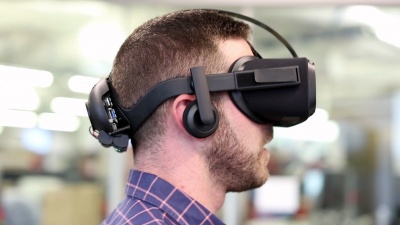Oculus Santa Cruz

| |
|---|---|
| Creator | Oculus VR |
| Operating System | Android OS |
| Image | |
| Optics | |
| Positional Tracking | Inside-out |
| Camera | 4 wide-angle cameras |
| Connectivity | 1 HDMI, 2 USB 3.0 Ports |
| Input | Controllers |
Contents
Introduction
The Santa Cruz is standalone, inside-out tracking virtual reality prototype headset being currently developed by the Facebook-owned technology company Oculus VR.
The first glimpse the audience had of the Santa Cruz headset was in October 2016. A video of the Santa Cruz headset was briefly shown at the Oculus Connect Event attended by thousands of VR developers and technology enthusiasts. Addressing the large gathering present there and to the millions more that connected to the event online, Mark Zuckerberg, CEO of Facebook, unveiled the VR headset and divulged the name of the prototype, Santa Cruz.
The Oculus team while unveiling the prototype attributed its birth to the tremendous progress they made in developing software for inside-out tracking.
Hardware
Oculus Santa Cruz is a standalone virtual reality headset. Unlike the company’s earlier models the headset is not attached to a personal computer via a wire. The new VR headset is wireless and needs no computer to power it. The standalone feature has, for the first time, made the Oculus VR headset completely mobile. The wearer is free to move around.
The Santa Cruz headset looks similar to Oculus Rift except that it’s untethered and has some additional features. The prototype comes with the spatial tracking feature and offers 6 DoF (Degrees of Freedom). This is vastly better than Samsung Gear mobile virtual reality headset, which has no spatial tracking and offers just three degrees of freedom. With these two features the user can put on the headset and move around; the physical movements will be fully recreated in the virtual environment.
The personal computer (PC) that was powering the VR headset has been replaced with a minicomputer at the rear end of the head strap. The motherboard that resembles a pack of playing cards is rumored to have one HDMI port and two USB 3.0 ports. Under the three ports is the headset’s rechargeable battery.
Inside-Out Tracking
Instead of the outside-in tracking feature that’s present in Oculus Rift, the Santa Cruz adopts the inside-out spatial tracking technique to track motion. In Santa Cruz, the external sensors are replaced by miniature cameras on the four corners of the front-end of the headset. The Oculus team has not made public the details of how the tracking feature works, but the team claims the wireless headset with its four cameras and powerful software can match the performance of the Rift.
The inside-out tracking technique was described as ‘one of the toughest problems in computer science’ by the Mark Zuckerberg. He went on to explain how the virtual reality software uses the inside-out and outside-in tracking techniques to capture physical motion. VR headsets that use outside-in tracking are normally connected to an external computer with the help of a cord; whereas, the inside-out tracking VR headsets are completely wireless.
Software
How does the Oculus Santa Cruz Prototype VR headset work? The details are still not fully clear, but it’s believed that through HDMI the data from the four cameras makes its way into the computer situated at the rear end of the headset strap. The date is then processed by the software which is presumed to run on the Android OS. The Oculus team did not reveal much about the processing power and other technical specifications, but it’s widely believed that the computer and the software play the most important role in creating the virtual reality magic.
The Oculus Santa Cruz Experience
At the Oculus Connect event, the team allowed two demos with the prototype. The users who tried the standalone VR headset had no complaints about the weight. Although they couldn’t see their hands and legs, they were able to move around the virtual world freely. Furthermore, with the headset on, when they neared a physical wall, they were alerted to its presence by the appearance of two translucent batteries. The Santa Cruz Prototype has a guardian system similar to HTC Vive.
Out of the two demonstrations, one was in a cartoon world. The purpose of the presentation was to showcase the inside-out tracking feature of the prototype. The spatial tracking technology allowed the users to look through the window and bend down to take a closer look at the animals, birds, flowers, and other animated objects in the virtual world.
The technology and the performance of the headset aren’t yet perfect, but the Oculus Santa Cruz has had a promising start. The Oculus Team is working hard to perfect its standalone VR headset.
Cost
No official announcement has been made about the cost of the retail version of the Oculus Santa Cruz VR headset.
Release Date
Oculus has not officially said anything about the release date for Santa Cruz standalone inside-out VR headset. The headset is still in its prototype stage. It’s believed that before the general populace gets to use the device, developers will have a go at the untethered VR headset.
References
- https://www.oculus.com/blog/oc3-reveals/
- https://arstechnica.com/gaming/2016/10/rift-goes-wireless-ars-walks-around-in-oculus-santa-cruz-vr-prototype/
- http://www.pocket-lint.com/news/139129-oculus-santa-cruz-standalone-headset-what-s-the-story-so-far
- http://www.roadtovr.com/hands-on-oculus-wireless-santa-cruz-prototype-makes-standalone-room-scale-tracking-a-reality/